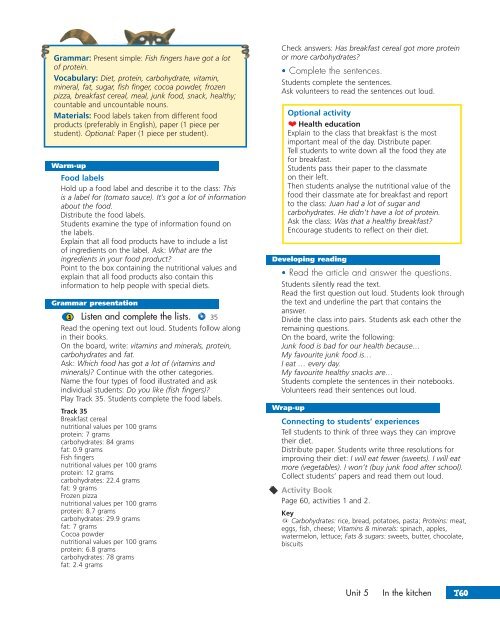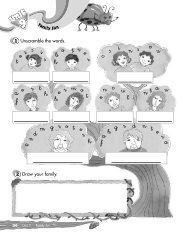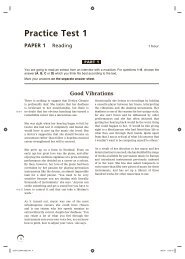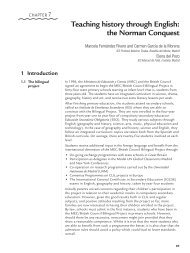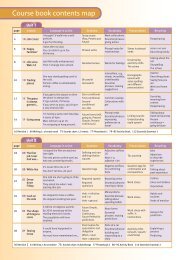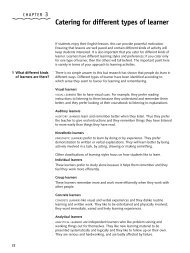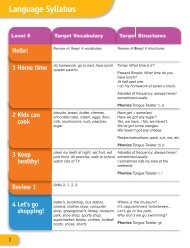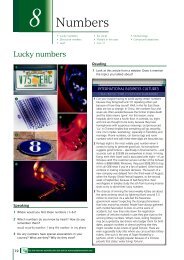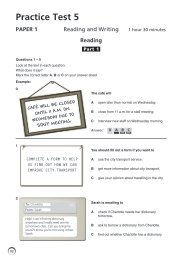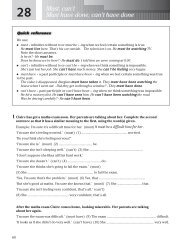Inthe kitchen
Inthe kitchen
Inthe kitchen
- No tags were found...
Create successful ePaper yourself
Turn your PDF publications into a flip-book with our unique Google optimized e-Paper software.
Grammar: Present simple: Fish fingers have got a lotof protein.Vocabulary: Diet, protein, carbohydrate, vitamin,mineral, fat, sugar, fish finger, cocoa powder, frozenpizza, breakfast cereal, meal, junk food, snack, healthy;countable and uncountable nouns.Materials: Food labels taken from different foodproducts (preferably in English), paper (1 piece perstudent). Optional: Paper (1 piece per student).Warm-upFood labelsHold up a food label and describe it to the class: Thisis a label for (tomato sauce). It’s got a lot of informationabout the food.Distribute the food labels.Students examine the type of information found onthe labels.Explain that all food products have to include a listof ingredients on the label. Ask: What are theingredients in your food product?Point to the box containing the nutritional values andexplain that all food products also contain thisinformation to help people with special diets.Grammar presentationListen and complete the lists. 35Read the opening text out loud. Students follow alongin their books.On the board, write: vitamins and minerals, protein,carbohydrates and fat.Ask: Which food has got a lot of (vitamins andminerals)? Continue with the other categories.Name the four types of food illustrated and askindividual students: Do you like (fish fingers)?Play Track 35. Students complete the food labels.Track 35Breakfast cerealnutritional values per 100 gramsprotein: 7 gramscarbohydrates: 84 gramsfat: 0.9 gramsFish fingersnutritional values per 100 gramsprotein: 12 gramscarbohydrates: 22.4 gramsfat: 9 gramsFrozen pizzanutritional values per 100 gramsprotein: 8.7 gramscarbohydrates: 29.9 gramsfat: 7 gramsCocoa powdernutritional values per 100 gramsprotein: 6.8 gramscarbohydrates: 78 gramsfat: 2.4 gramsCheck answers: Has breakfast cereal got more proteinor more carbohydrates?Complete the sentences.Students complete the sentences.Ask volunteers to read the sentences out loud.Optional activityHealth educationExplain to the class that breakfast is the mostimportant meal of the day. Distribute paper.Tell students to write down all the food they atefor breakfast.Students pass their paper to the classmateon their left.Then students analyse the nutritional value of thefood their classmate ate for breakfast and reportto the class: Juan had a lot of sugar andcarbohydrates. He didn’t have a lot of protein.Ask the class: Was that a healthy breakfast?Encourage students to reflect on their diet.Developing readingRead the article and answer the questions.Students silently read the text.Read the first question out loud. Students look throughthe text and underline the part that contains theanswer.Divide the class into pairs. Students ask each other theremaining questions.On the board, write the following:Junk food is bad for our health because…My favourite junk food is…I eat … every day.My favourite healthy snacks are…Students complete the sentences in their notebooks.Volunteers read their sentences out loud.Wrap-upConnecting to students’ experiencesTell students to think of three ways they can improvetheir diet.Distribute paper. Students write three resolutions forimproving their diet: I will eat fewer (sweets). I will eatmore (vegetables). I won’t (buy junk food after school).Collect students’ papers and read them out loud.Activity BookPage 60, activities 1 and 2.KeyCarbohydrates: rice, bread, potatoes, pasta; Proteins: meat,eggs, fish, cheese; Vitamins & minerals: spinach, apples,watermelon, lettuce; Fats & sugars: sweets, butter, chocolate,biscuitsUnit 5 In the <strong>kitchen</strong> T60


